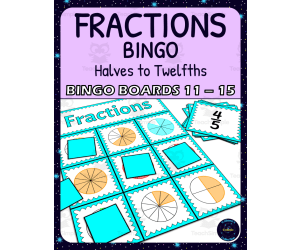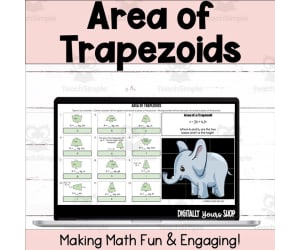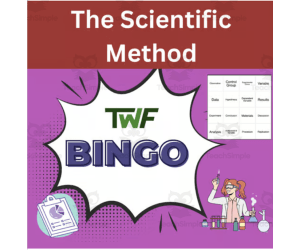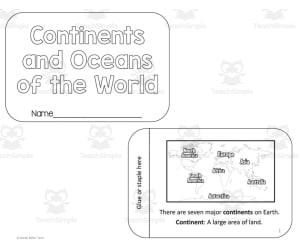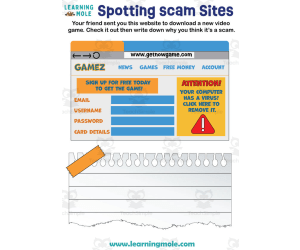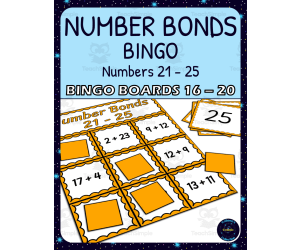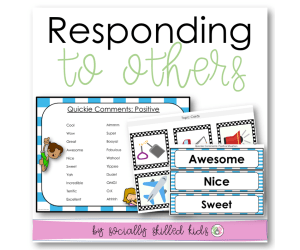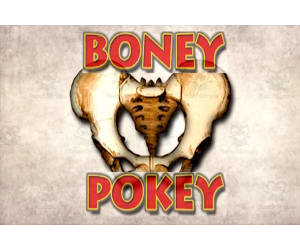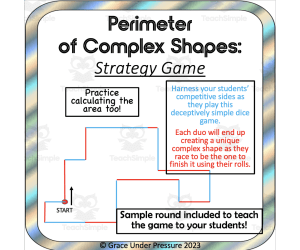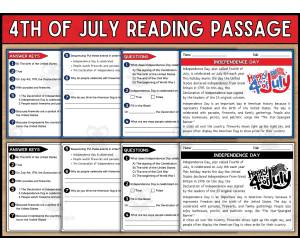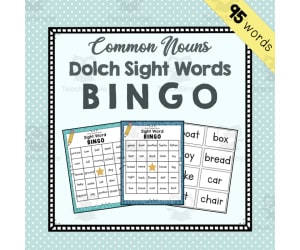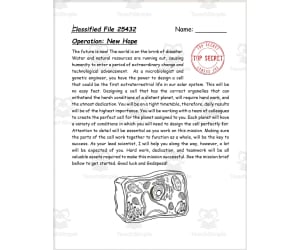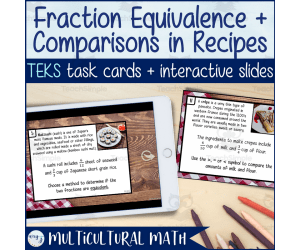3,313 products added recently
Page 364 - Cut and Paste Activities
Enhance learning through tactile experiences with cut and paste activities that combine creativity and skill development. This collection includes sorting exercises, craft projects, and interactive worksheets. By integrating these activities into your lessons, you can support manual dexterity and engagement.
Common Fractions 1/2s - 1/12s Activity - Bingo Game - Fraction Circles - Boards 11-15
Math, Fractions, Grade 2, 3, 4, Activities, Games
Common Fractions Bingo for 1/2s to 1/12s Students will love practicing common fraction identification with this engaging bingo game! The set includes calling cards with circles, squares, strips and symbols representing fractions from halves to twelfths. Also included are 5 different bingo boards in color and black and white. To play, students cover squares on their board when their fraction matches the calling card. The first to get 3 in a row wins! Boards can be used with dry erase markers and wiped clean after each game. An inexpensive way to reinforce fraction skills that can be differentiated by varying the complexity of fractions called. Use for individual, small group or whole class practice identifying common fractions. Extend learning by creating additional boards or calling cards.
Author Colleen's Cosmic Collection
Tags Fractions, Common Fractions, Fraction Games, Fraction Activities, Fractions Bingo, Math Game, Math Activity, Common Fractions Game, Common Fractions Activity, Cccfbtc
"Richard Arkwright – Industrialist" - A History Play
Social Studies, History, History: USA, Grade 9, 10, 11, 12, Activities
Richard Arkwright - Industrialist: A History Play This valuable teaching resource is ideal for grades 9-12 social studies instructors focusing on U.S. history or homeschooling parents. Delivered as a succinct two-page Word document, it presents an in-depth look into the Industrial Revolution, with particular emphasis on the roles of Entrepreneurs and Inventors. Learning by Engaging in Character-driven Play The play portrays Richard Arkwright - renowned as the Father of the Factory System and gives an insight into characteristics typical for British Industrialists during this era. Educators can infuse authenticity and excitement into their lessons through character-led narratives such as Margaret Arkwright’s dialogue scene from behind a slightly open door. Post-Performance Learning Activities A discussion to assess comprehension A quick written exercise for learners to take note of whatever they remember about Richard Arkwright's narrative. An opportunity to use the play in whole-group instruction or read aloud activity in small learning clusters depending on classroom dynamics.No need for individual scripts as you can retain narration control. This history play offers several possibilities: Distributed via platforms like tablets or computers, it adapts well within traditional classroom settings but is also conducive towards home-based learning environments. Fostering Memorability & Engagement with Historical Facts through Interactive Learning: "Richard Arkwright – Industrialist: A History Play,” hence brings lively engagement that helps learners grasp crucial points about inventions, entrepreneurs and labour factory system during industrial revolution. The approach actively involves each student's participation making studying history not only more engaging but also memorable while ensuring efficient acquisition of knowledge.
Author BCM Creations
Tags Industrial Revolution, Richard Arkwright, Entrepreneurs, Factory System, History Play
Money in Music (Student Research Project on Money in Popular Culture)
Social Studies, History, Psychology, Research, Grade 7, 8, 9, 10, 11, 12, Activities
Money in Music is an engaging student research project exploring perceptions of wealth, capitalism, and materialism in popular music. This 55-page teaching resource guides students to analyze song lyrics and think critically about themes relating to money. Videos and music clips are embedded to showcase examples.\n\nWell-designed presentation slides introduce big ideas like capitalism, critiques and benefits of capitalism, perceptions of wealth in pop culture, and more. Clear instructions are provided for the student research project. Students will choose a song, analyze the lyrics, and connect themes back to capitalism, materialism, and values. Discussion questions facilitate reflection. This cross-curricular resource develops media literacy, critical thinking, and research skills relevant across subjects. It is designed for grades 7-12.
Author Ed Dynamic
Tags Music, Money, Capitalism, Wealth, Values
Area of Trapezoids Self-Checking Digital Activity
Math, Geometry, Measurements, Grade 6, 7, Activities
Area of Trapezoids Self-Checking Digital Activity Navigating the geometrical concept of trapezoids' area calculation can be quite challenging for students. Teachers and homeschoolers alike are on the lookout for unique methods to simplify this concept and foster interest among the learners. This need has led to the development of the Area of Trapezoids Self-Checking Digital Activity , specially designed for seamless integration into math education for 6th & 7th-grade students. About The Activity An engaging digital activity functioning within Google Sheets, transforming every question about trapezoid areas into self-checking problems. The setup is exciting — after making calculations on a whiteboard or provided recording sheet, learners enter their answer into a specific cell. Each correct response reveals part of a mystery picture — encouraging accuracy while infusing fun elements in math learning. The digital resource includes an optional 'Show Your Work' page where individual mathematical processes are documented—encouraging understanding beyond merely getting correct answers. A teacher's answer key is included to simplify grading and saving valuable time that can be dedicated to organizational learning rather than grading assignments. Flexibility & Adaptabilityof The Package The package allows significant flexibility during execution; i.e., it can function as morning work or homework assignment material. Additionally , since it 's entirely hosted on Google Sheets , this activity becomes incredibly adaptable and easily shared across platforms like Google Classroom or other e-Learning management systems - making distant learning situations a breeze. Aligned Learning Goals Please note that this activity aligns perfectly well with common standards and desired learning goals such as 6.G.1 & 7.G.B6, which focus on mastering trapezoid area calculations. Quick Summary: Grades applicable: Grade 6 & Grade 7 Subjects: Math {@Chris}: : Geometry, Measurements Type : Activities The file type withstand: Google Sheets
Author Digitally Yours Shop
Tags Trapezoid Area, Digital Activity, Self-checking, Geometric Shapes, Math Education
Sound Spelling Song #5
Creative Arts, Art, ELA, Music, Language Development, Spelling, Preschool, Grade 1, 2, Songs, Activities
We are always looking for ways to teach our students new skills. Being able to tailor instruction to their learning styles is just one effective way to increase student engagement and set students up for success. Many of our students, from year to year, are visual and auditory learners. Most children (and even adults) can attest to their ability to better retain information that they have learned through music and song. Because of this, my resources seek to teach students skills through song. This particular resource is aSound Spelling Song #5.This can be used in your reading classroom with your lower elementary students in kindergarten, 1st and 2nd grade. Included in this resource: --Sound Spelling MP4 video Student will love learning and reviewing these words (cab – snack) with the many options included here. You can use this video to introduce these words and their spelling patterns. You may choose to incorporate it into your lesson’s presentation , so it is easily accessible for you. Students will listen to this song and be able to make connections to the other components of the lesson as well as any independent work they may be doing. I hope you enjoy! Here are other similar resources for you to enjoy: Adding Doubles Song (1 to 10) Basic Addition Song (8+1 to 8+9) Sing Along Times Tables for 13x1 – 13x15 C Words Video Prepositions Song Verb Song Packet You can find more resources at my storefront here: https://teachsimple.com/contributor/audio-memory
Author Audio Memory
Tags Sound Spelling Song, Spelling Song, Reading Music, Phonics, Spelling Patterns, One Syllable Word, Two Syllable Words, Music
Solving 2-Step Equations PARTNER PRACTICE
Math, Algebra, Grade 7, Activities
Solving 2-Step Equations PARTNER PRACTICE Unlock the fascinating world of Algebra with Solving 2-Step Equations PARTNER PRACTICE, a teaching tool specifically crafted to address the Expressions & Equations Standards set by CCSS.MATH.CONTENT.7.EE.B.4. This resource encourages an interactive teaching approach that applies problem-solving scenarios tailored for rational numbers. Features: An emphasis on equations of forms 'px + q = r' and 'p(x + q) = r', enhancing fluency in solving them. Structured exercises that support various teaching strategies – whole-class discussions, small study groups, homework assignments or quick reviews. Design as a collaborative activity with two forms - Form A and Form B - each providing different questions but identical answers enabling self-checking and error correction among partners. Included answer keys for easy comprehension level assessment by teachers. Digital Convenience: The tool is offered in PDF format, heightening convenience when printing or sharing online. It effectively hones your student's problem-solving capabilities focusing primarily on pivotal algebraic operations linked to real-world problems. What this resource covers: The Solving 2-Step Equations PARTNER PRACTICE training resource introduces learners to: Kickstarting critical thinking skills through direct result comparison within partner-based exercises An intriguing blend of theoretical content and hands-on practice tasks spanning from basic calculations to abstract reasoning essential for mastering complex maths like equation solving. The contributions variables make in practical situations along with mathematical assumptions.
Author The Math Cafe
Tags Equations, Algebra, Problem-solving, Rational Numbers, Interactive
The Scientific Method Science BINGO Activity
Science, Earth and Environmental Sciences, Earth Sciences, Grade 6, 7, 8, 9, 10, 11, Activities
Your students will love this engaging science review activity. Everyone loves BINGO and it makes for a great review activity that is fun and competitive. This interactive game reinforces key scientific concepts and theories, ensuring curriculum relevance and accuracy. The game package includes 36 unique 4x4 bingo cards featuring essential terms and concepts from The Scientific Method, a set of call-out cards with clear and concise definitions tailored to the students' level, and detailed gameplay instructions. Here is a sample from the instructions. BINGO – Instructions, Terms, and Descriptions Cut out and distribute the BINGO cards to your students. Each student will get a unique card. Students can use markers or chips to cover squares that have been called. Print out and cut out each term/description below – these are the call-out cards. Fold each call-out card and place in a hat or box and remove one at a time. After you’ve read the call-out card description, your students are to place a marker on the term associated with the description located on their card. The first student to get 4 in a row horizontally or vertically, wins. Ensure accuracy by checking marked terms on student card to the called-out descriptions.
Author Teach With Fergy
Tags Science Bingo, Bingo Activity, Scientific Method, Scientific Method Activity
Continents and Oceans Flipbook Activity
Social Studies, Geography, Preschool, Grade 1, 2, Activities
This resource is a Continents and Oceans Flipbook Activity . All you have to do is print and assemble. Students will love learning about these geographical locations across the world. The flipbook is printed in black and white making it easy for students to color the pictures.
Author Sarah Miller Tech
Tags Continents, Oceans, World, Geography, Flipbook, Teach Continents, Contents And Oceans, Contients And Oceans
Spotting Scam Sites Activity
Life Skills, Special Resources, Technology, Science, Grade 3, 4, 5, 6, 7, 8, 9, 10, 11, 12, Activities
Activity Introduction An amazing activity designed for the students to learn more about social and soft skills in our daily life. Spotting Scam Sites Have you ever read about soft skills or social skills? If yes, can you tell us more about them? Body language is so important for us to learn about, as it teaches us how to deliver the correct message to the people we are talking to, and get the right message from the people who talk to us, by simply reading their body language. What do you know about etiquette? Do you know that every country has got its unique etiquette? What do you know about online etiquette? What is your strongest soft/social skill? Can you name other social or soft skills? Do you think we should be always nice to our friends and family? Do you think we should be kind with animals? Have you ever read about online etiquette? If yes, tell us more about it. What are the essential skills that we should have while dealing with people online? Spotting Scam Sites Activity The activity is perfect for encouraging the researching skills for the students, while learning more about these fantastic social and soft skills in our daily life. Spotting Scam Sites This friendly designed worksheet is suitable for students at school, homeschooling, and as a group activity. Instructions Your friend sent you this website to download a new video game . Check it out then write down why you think it’s a scam. Format Available in a PDF format.
Author Educational Voice
Tags Spotting Scam Sites Activity, Spotting Scam Activity, Scam Sites Activity, Spotting Scam Sites, Spotting Scam Sites Facts, Spotting Scam Sites Facts For Kids, Scam Sites, Scam Sites Facts
Number Bonds 21-25 Bingo - Boards 16-20
Math, Fact Families, Addition and Subtraction, Addition, Grade 1, 2, 3, Activities, Games
Number Bonds 21-25 Bingo teaches number bonds for 21-25 in a fun, engaging way. This math game includes 5 colorful bingo boards with corresponding calling cards. To play, students cover number bonds on their boards as the teacher draws and calls out cards. The first student to cover 3 spaces in a row wins! This game helps cement number bonds concepts, keeping students focused and engaged. Use it in small groups, whole class, or as a homework assignment. Pair with other resources like number bonds worksheets, skip counting games, and times tables activities for a comprehensive approach. With just basic preparation - print, laminate, cut, shuffle and you're ready to play, this game encourages number sense fluency. Students will ask to play again and again!
Author Colleen's Cosmic Collection
Tags Number Bonds, Number Bonds Games, Addition Game, Addition Activity, Math Facts, Addition Facts, Addition Math Facts, Math Fact Practice, Number Bonds To 25, Cccnbb2125
Emoji Emotions Fan
Special Resources, Life Skills, Not Grade Specific, Activities
Developing emotional intelligence is a critical part of early childhood education. When children can recognize and label emotions, they gain self-awareness and empathy. This vibrant emotions fan set helps teach feeling words through engaging activities. The 15 illustrated fan pieces each feature a different emotion face and word. Expressions like happy, sad, angry, surprised, and more build children's emotional vocabulary. Educators can prompt conversations about when we feel certain ways and how our faces show it. Recognizing facial cues to identify feelings teaches valuable social-emotional skills. These fans support self-awareness as children learn to articulate their own emotions rather than acting out. The visuals also help nonverbal students express feelings. Children can use the fans to communicate how they are feeling throughout the day. Beyond self-understanding, recognizing others' emotions fosters supportive relationships. With colorful cartoons and essential feeling words, these fans turn emotional learning into interactive games . Children will delight in matching faces and words while gaining the vocabulary to express themselves. Self-regulation and friendship skills stem from an ability to read and discuss emotions. This engaging resource brings those critical lessons to life in a child-friendly way. These fans contain 15 pieces which include the emotions: happy, sad, scared, calm, worried, excited, furious, annoyed, disappointed, miserable, confused, poorly, angry, tired and embarrassed. Clipart images courtesy of Hidesy’s Clipart.
Author SEN Resource Source
Tags Emotions, Feelings, Feelings Recognition, Social-Emotional Learning, Emotional Intelligence, Emotional Literacy, Mental Health, Emotion Regulation, Self-Awareness, Emotional Well-being
Responding To Others, Conversational Skills For 1st-5th Grade
Special Resources, Social Skills, Grade 1, 2, 3, 4, 5, Activities
Responding To Others, Conversational Skills For 1st-5th Grade is a valuable teaching resource. It enhances students' conversation skills of expressing interest in others through questions, comments and connections. It is also packed with activities to engage learners. This teaching resource includes: Three distinct activities presented across multiple levels for customised learning. A total of 72 pages full of content including instructions and discussion sheets. Cards presenting various conversational scenarios for practicing learned skills. Activity one - Quickie Comments: With this activity , students explore positive and negative responses using prepared comments. They engage with story cards that they can read individually or in groups. Includes: 27 positive response options + 18 negative response comments Editability: Sections for customised content as per classroom needs Activity two - Curious Questions: This activity encourages learners to practice forming questions using a supplied question starters poster. An interesting comparison challenge between 'Curious' & 'Questionable' questions enhances critical thinking while reinforcing questioning techniques. It comes along with an editable section for tailored requirement fitting. There are ten question prompt cards included as well. Activity three - Considerate Connections: In this module, students are guided on how to make considerate connections within conversations. They get an opportunity to identify if given statements are considerate or careless ones enhancing comprehension check-ins such that: The scenario sessions come pre-made along with editable sections providing flexibility in planning lessons . Students can exercise their newly learned skill This resource caters to the learning needs of students in grades one to five and can be deployed in small group learning sessions or classroom exercises. The product file format is a PDF which makes it easy-to-use as a digital teaching resource. It has been designed keeping remote teaching and homeschooling applications in mind while aiming to develop effective communication practices among young learners. Making conversation education enjoyable for students during these formative years, this blends learning with fun.
Author Socially Skilled Kids
Tags Conversation Skills, Social Interaction, Asking Questions, Making Comments, Connections
All About Me - 'When I was a baby' Sheets
Special Resources, Social Emotional Learning (SEL), Kindergarten, Preschool, Grade 1, Activities
These sheets ask the children to think about how they have changed since being a baby. There is space for drawing, writing or both! There are 4 sheets in the pack.
Author Little Owls Resources
Tags Growth, All About Me, Transitions, Moving On, Ourselves
Body Systems - Bell Ringers, Class Warm-Ups, and Exit Tickets
Science, Life Sciences, Human Body, Grade 9, 10, 11, 12, Activities
This Body System unit comes with 20 days’ worth of materials that relate directly to The Digestive System, Circulatory System, and Respiratory System. This activity bundle is geared towards a grade 8-11 Biology class. They can be used at the start of a class in the form of a bell ringer/class warm-up or at the end of class as an exit ticket. Would you like to see me walk through my Bell Ringer activity ? I created a video that overviews how they work and how you can use them effectively in your classroom in only 5 minutes per day. Click here to have a look. This resource covers the following topics • Digestive System Structure and Function • Circulatory System Structure and Function • Blood vessels, blood, heart • Respiratory System These are meant to be used each day, however, the question periods are directly associated with topic lessons, so they are done on days that follow the completion of a lesson. For example, after you finish your lesson, you’d give your students the questions associated with the ecosystems lesson. Additional days will utilize the Quotes and Videos sections. There are two key reasons why this daily activity works: 1) It encourages your students to review their notes on a nightly basis so they’re ready for class. 2) It creates a routine in your classroom that encourages your student to arrive and get settled for class quickly and quietly. Once we’re done, the students are ready for class and have already gotten their brains working and thinking science. The Activities 1) Questions: Question types - Fill in the blanks - Short answer - Opinion - Drawing - Mix of above ● Everything will be included in your PowerPoint ● All questions relate directly to the previous lesson and work to test your students’ understanding ● If students are absent, they know they need to get caught up while away ● This process encourages students to keep up with the material and review their notes nightly 2) Quotes The quotes come from individuals and relate directly to the overarching topic. On these days, I have students read the quote and write down what they feel it means and/or the underlying message. 3) Videos The videos are an excellent way to settle your class down quickly and easily. Each video is selected specifically because it’s interesting and relevant to students. Each video can be accessed directly from the slide. Simply click the video image while in slideshow mode and the video will automatically open in your browser. Process ● Each week, I hand out the week’s [Topic Name] - Student Worksheet ○ You can make this activity completely digital by making the sheet available online and have them submit it there as well ● As soon as the bell rings to start class, I hand the sheets out to my students. Once the sheets are out, I start the 4-minute timer. If students are late, they miss out on their time. �� Once the timer finishes, the students flip over their papers and pass them to the front. Structure Each day’s activities, unless otherwise stated, are to be done individually and without notes. However, depending on the ability level of your students, you may want to have them work in pairs and/or use their notes. Marking We all have enough marking already and the last thing we want to do is add to our pile. However, I’ve found that this process is so streamlined and efficient that I’m easily able to mark these while my students are working in class or copying down notes. Typically, I mark only the Questions section. However, if I’m busy or don’t have time in class, I won’t and that’s OK. The point of this isn’t to make your job harder but to help your students stay on track and keep focused. Additionally, I’ll mark one of the other sections (Quote or Video) at least every other week. Each day’s mark is out of 5 but since there aren’t always 5 questions (usually it’s somewhere between 1-3), I base my mark on their understanding of what I’ve asked them to complete. This can come across as subjective, but I’ve found it gives me an excellent indication of their knowledge and keeping it consistent makes things better for everyone. Keep in mind that the outline above describes how I use them in my class. Feel free to change it up however you like (including the questions as the entire thing is completely editable). Other teachers I’ve spoken to only utilize the questions following a lesson or only mark the questions following a lesson and for the other days, show the relevant videos but don’t require their students to submit anything. A few people only mark one submission per week while others mark everything. It’s completely up to you. Whether you use Questions, Quotes, or Videos in any given lesson, your goal is to create a routine, promote understanding, and get your students thinking about science as soon as they enter your class. ***************************** For free resources, useful teaching tips, and tools, please visit my blog - TeachScienceWithFergy.com If you have any questions please feel free to send me an email - devon@teachwithfergy.com
Author Teach With Fergy
Tags Anatomy Lesson, Body Systems, Bell Ringers, Science Exit Tickets, Body Systems Powerpoint, Body Bell
The Boney Pokey Dance!
Science, Life Sciences, Human Body, Preschool, Grade 1, 2, 3, 4, 5, Activities
Students dance and learn the names of some of their body's bones in this Hokey Pokey style song.
Author Ethics4Schools
Tags Human Bones, Anatomy, Science, Dancing, Activity, Ethics4Schools
FREE SODUKU GAME WITH ICONS | BRAIN GAME
Special Resources, Adult Education, Early Learning, Elementary, High School, Homeschool Resources, Middle School, Not Grade Specific, Pre-K, Activities, Worksheets & Printables
FREE SODUKU GAME WITH ICONS | BRAIN GAME INTRODUCTION: We are EDITORIAL ARENAS EDUCATIVAS, a publisher dedicated to designing educational resources for primary school children approximately between the ages of 3 and 12 who are learning mathematics, literacy, as well as worksheets for learning Spanish and some brain exercises. MAIN INFORMATION: 1. Brief introduction: Hello, thank you very much for being interested in this educational document. This document will help you a lot both in the classroom if you are a teacher, as well as if you homeschool and want to stimulate your children from home. 2. Title of the educational resource: This document is titled "Teaching material for children" 3. Topic to work on: Thanks to this educational document, we are going to work on a basic topic that every child and/or student should master. 4. Area of knowledge where it should be applied: Thanks to this document, we will address a topic and at the same time an important area of learning. 5. Number of pages it contains: This educational document contains the following number of pages available and ready to be used by you, you just have to download and print the document to start using it in your classroom. SECONDARY AND COMPLEMENTARY INFORMATION: 6. In what area of knowledge can it be applied? You can apply this set of educational sheets according to your criteria, in the corresponding area. 7. Should I apply it individually or as a group in my class? Also, according to your criteria, see if it is better for these sheets to be applied individually or as a group. 8. What size and format is this resource in? This set of teaching sheets has been published in A4 size, PDF format, so that it is much easier to use. 9. Do I need any extra elements to apply it? Yes, perhaps your students need pencils, colors, markers and even sometimes scissors and erasers. 10. Is it in color or black and white? This educational document has been designed mostly in color so that it is highly attractive to students. 11. Is this resource free or do you have to pay to use it? This document is available for free, so take advantage of the opportunity to download it now. 12. Does it have an answer key attached? No, it does not contain an answer key attached. This file is for personal use only. It is not allowed to be resold or shared with others.
Author EDITORIAL ARENAS EDUCATIVAS
Rating
Tags FREE, FREE RESOURCES, GAME, BRAIN GAMES, SUDOKU
Perimeter of Complex Shapes: Math Strategy Game
Math, Geometry, Measurements, Grade 3, 4, 5, 6, 7, Activities, Games
Harness your students’ competitive sides as they play this deceptively simple dice game that lets them practice calculating the perimeter of complex shapes. Each duo will end up creating a unique complex shape as they race to be the one to finish it first using their rolls. Students can also calculate the area of their personal shape for extra math practice. A sample round is included to teach the game to your students! Instructions: 1) Player 1 chooses a starting spot, rolls, and draws a line that length (no diagonals). 2) Player 2 starts at the end of Player 1’s line, rolls, and draws a line that length. 3) Once the perimeter is over 40 units, the first player to close the shape wins! 4) If you can’t close it with the rolls you get, it is a tie. 5) BONUS: Calculate the area of your completed complex shape (close it yourself if the rolls did not complete it). Grades to Use With: This game works well for students in grades 3-7. Depending on where you live it may meet these standards: CCSS 3.MD.C.5 Recognize area as an attribute of plane figures and understand concepts of area measurement. CCSS 3.MD.D.8 Solve real world and mathematical problems involving perimeters of polygons, including finding the perimeter given the side lengths, finding an unknown side length, and exhibiting rectangles with the same perimeter and different areas or with the same area and different perimeters. British Columbia, Canada: Grade 6 Learning Standard: Perimeter of Complex Shapes If you enjoy this math game, check out some others in my store: Theoretical and Experimental Probability: Hands-on Math Task with Fractions and Percentages Grocery Game: Estimating, Multiplying, and Adding Decimals Pre-Algebra Expression Input/Output Game
Author Grace Under Pressure
Tags Perimeter, Area, Complex Shapes, Dice Game, Compound Shapes, Hands-on Math, Math Center, Math Game, Math Station, Strategy, Math Strategy Games
Letter O Vocabulary and Tracing Cards
ELA, Language Development, Phonics, Writing, Handwriting, Kindergarten, Preschool, Worksheets & Printables, Flashcards, Activities
Students can practice reading and writing letter O words with these vocabulary and tracing cards. These cards include bold, clear images of objects and ideas that begin with the initial sounds of the letter O. These vocabulary and tracing cards are suitable for preschoolers and kindergartners who are beginning to learn about words, letters and handwriting. The vocabulary cards provide a way for students to identify things that start with the letter O and the tracing cards provide students with a fun way to practice letter formation and writing words. These cards include both the long O sound and the short O sound. What is Included: * 12 Vocabulary cards * 12 Tracing cards * Words included - otter, octopus, octagon, office, ox, ostrich, omelet, olive, open, ocean, over, oval When to Use * Literacy Center * Writing Center * Wall display in writing or reading center * Small Group Activity * Pocket Chart Display * Word Wall Cards * Flash Card Activity The vocabulary cards can make a great wall display in a writing center or as part of a word wall. Students will be able to reference the cards when writing or labeling pictures. These cards can also be used as a pocket chart activity where the teacher can introduce different letter O words. Students can also utilize the pocket chart to sort the words by long or short vowel sounds of the initial O sound. Skills Assessed * Beginning Sounds * Tracing Skills * Letter Formation * Handwriting These cards are a low prep activity for teachers to create. The teacher simply needs to print the cards and cut them out. The cards can be laminated if desired. By laminating the tracing cards, the teacher can create a write and wipe activity that students can reuse over and over.
Author The Connett Connection
Tags Letter Of The Week, Writing Center, Tracing Activity, Word Wall Cards, Alphabet Activity, Tracing Words, Letter Formation, Handwriting Practice, Letter O, Letter O Activities
4th Of July Reading Passage - Independence Day Reading Comprehension
Reading, ELA, Elementary, Read Alouds, Activities
The 4th of July, also known as Independence Day, celebrates the adoption of the Declaration of Independence on July 4, 1776. It marks the United States' independence from Great Britain. The day is celebrated with fireworks, parades, barbecues, and patriotic displays across the country. Are you looking for a fun and engaging way to celebrate Independence Day? This reading passage is a great resource for celebrating 4th Of July Day in schools while practicing reading skills. This educational resource features simple, kid-friendly pages designed to make learning both enjoyable and interactive. Great for homeschooling, classroom education, or extra practice. Number of pages: 8 pages (4 BW + 4 COLOR) Format PDF file size: 8.5*11 Inches If you and your students or your children enjoy using this educational and engaging resource. please rate it and follow my store to be the first to know about my new teaching resources and freebies. Enjoy!
Author Wonderland School
Tags Independence Day, US Independence Day, Independence Day Reading Passage, Independence DayColoring Pages, 4th Of July, 4th Of July Reading Comprehension, 4th Of July Activities, 4th Of July Worksheets, Independence Day Worksheets, Independence Day Activities
Common Nouns: Sight Word Bingo
ELA, Grammar, Reading, Language Development, Spelling, Grade 1, 2, 3, Activities
Common Nouns: Sight Word Bingo Common Nouns: Sight Word Bingo is an educational resource designed for teachers and homeschoolers alike. This teaching tool uses the well-established list of most often used words in English language that Edward Dolch carefully compiled in 1948 and presented in a format conducive to fun learning - a sight word bingo game - making it perfect for Grammar, Reading, and Spelling focus areas within Language Arts lessons. This resource includes material derived from Dolch's known 220-word list. The game focuses specifically on the Common Noun section, which comprises 95 frequently used nouns that assist children from Grade 1 to Grade 3 to enhance their reading and writing skills. The sight word bingo game integrates several engaging activities into one intelligently crafted package aimed at making the arduous task of learning new words fun-filled rather than intimidating. With this tool, repetitive exposure helps students recognise words swiftly leading them towards fluent sentence-building. A Flexible Tool with Record Keeping Capability This flexible tool can be employed for whole class instruction as well as small group activities or homework assignments due to its print-friendly format. It also contains a helpful student progress record sheet allowing educators and learners both to keep track of improvement. An introductory article discussing Dolch Sight Words, The Common Noun Dolch Sight Word List, A student record sheet for common noun sight words, Forty unique sight word bingo game cards, Ninety-five teacher draw cards. Print Ready Educational Kit! This thoughtfully organized sightword BINGO kit consists of fifty-three pages of engaging content available for print and promises enriching classroom experiences that advocate literacy development per Edward William Dolch's research.
Author Simply Schoolgirl
Tags Sight Words, Dolch List, Common Nouns, Bingo Game, Literacy Development
Free Digital Gratitude Activity for Elementary Students
Special Resources, Social Emotional Learning (SEL), Life Skills, Grade 3, 4, 5, 6, Activities
Free Digital Gratitude Activity for Elementary Students Engaging students meaningfully, especially on abstract concepts like gratitude, can present a challenge for teachers. The Free Digital Gratitude Activity is specifically designed to overcome this hurdle by fostering gratitude appreciation among elementary students through an interactive and fun exercise. Cleverly crafted to promote creative thinking, this digital activity encourages students to identify something they appreciate corresponding to each letter of the alphabet. Unlike typical activities where answers can be simplistic or repetitive, this method forces them to think innovatively and diversely about things around them which they are grateful for. The procedure is quite simple; after brainstorming their thankful item for every alphabet letter, they find a picture representing it and paste it on their slide. As an integral part of the learning process, they will then explain why each item was chosen in class discussions or presentations. For instance, 'X' could trigger expressions of appreciation for extra video game time. Versatile in application - From individual assignments at home to small groups in classrooms or even as an engaging whole group activity – the flexibility maximizes its utility across various teaching methods and settings. Efficacy beyond physical classrooms - Tteachers conducting online sessions have found it equally effective. Suitability - Ideally suited for Grades 3-6 under Special Resources aligning with subjects focusing on Social Emotional Learning and Life Skills development among children within these age groups. Minimalist tool requirement - A Google slides-based exercise that doesn’t overwhelm learners with technical complexity while retaining efficacy across platforms or classroom environments. Whether you’re planning Thanksgiving Week activities that reinforce positive values or simply need a unique way for motivating less enthusiastic learners during morning meetings – this free digital gratitude activity serves multiple needs seamlessly while maintaining a consistent focus on the key learning objective: instilling genuine gratitude. Packed into a convenient PDF format ensuring easy download processes across all devices - teachers finally have access to an invaluable resource combining a highly engaging educational activity promoting gratitude appreciation at zero cost.
Author The Feelings and Friends Teacher
Tags Gratitude Activity, Elementary Students, Digital Learning, Social Emotional Learning, Interactive Exercise, Lessons On Gratitude For Elementary
French Fries Blended Word Family Game
ELA, Language Development, Phonics, Preschool, Kindergarten, Grade 1, 2, 3, Activities, Games
Product Description French fries blended word family game and/or activity is great for literacy centers and phonic lesson for phonics phase 4. This product is useful for young children and to learn digraphs sounds, new words and expand their vocabulary, and practice reading using french fries matching clip arts. Directions for use: To prepare the templates for use by printing the pages you wish to use and laminate them for durability. All clip arts will need to be printed and cut before use, with the option to laminate for durability. Foldable box: Cut around the solid line, fold on the dash line, and glue the sides together. 2D box: Cut around the clipart, cut a slit on the dash line to slip in the french fries. Uses for product Flashcards Wall tiles Phonic class Literacy centers Decoration Word recognition Sound recognition New vocabulary Teach digraphs Guided Reading Phonics Game
Author Koodles Clubhouse
Tags Phonics, Blend Words, Word Family, Digraphs Sounds, Reading Practice
Extraterrestrial Organelle Design
Science, Basic Science, Grade 7, 8, 9, Activities, Projects
Extraterrestrial Organelle Design A comprehensive teaching resource meticulously constructed for Grade 7, Grade 8, and Grade 9 Science educators. This dynamic instructional tool offers a unique approach to practical studies on cell biology. The Theme Following an imaginative theme of space exploration - framed within the hypothetical stakes of the next SpaceX New Hope mission – this project instigates research, creativity, and teamwork among students. Teams embark on a thrilling quest to fabricate organelles designed for challenging alien environments. The Stages Understanding their assigned planet's specifics. Conceiving cells suitable for survival there. Naming the organelle based on its function in the cell. Sketching its proposed appearance inside the cell. Giving a thorough explanation exhibiting their understanding of each organelle’s role. The Elements Included: Detailed charts for designing and naming organelles. \ Propositions for extension activities.\n An easy-to-follow rubric for unbiased evaluation. This structured task is included in 17 integral pages available as Microsoft Word file type format allowing adaptability across varied educational settings like small group work or whole-class instruction – ideal both home-based learning as well as public school curricula purposes. Designed adhering carefully around Basic Science standards required at junior high levels; Educators can cater this innovative project-based learning proposal regularly or sparingly based on their specific teaching objectives proving handy both as fun-filled recaps post-lecture sessions or intensive coursework assignments.
Author Mitchell Zuvela
Tags Organelle Design, Extraterrestrial Theme, Cell Biology, Practical Studies, Space Exploration
Fractions: Equivalent & Comparing
Social Studies, Geography, Math, Fractions, Grade 4, Activities
Fractions: Equivalent & Comparing Resource Overview This resource is an innovative tool for educators, designed to make complex topics such as fractional equivalencies and comparisons relatable for fourth graders. The primary method involves an exciting blend of culinary exploration and math education, using diverse cultural recipes as practical examples in problems. This approach not only delivers crucial math skills, but it also fosters diversity, equity, and inclusion amongst students. Adhering firmly with the Texas Essential Knowledge and Skills (TEKS), this resource conforms strictly to rigorous academic standards. Delivery Options Educators can choose from the classic printable task cards or delve into interactive digital slides compatible with Google + PowerPoint platforms. This enables flexibility for: Teaching whole-group lessons Facilitating small study groups Setting up math centers Conducting games to reinforce taught concepts regardless of format chosen - physical or digital. Included Resources - Physical Version Details: This version includes:, Sixteen compelling task cards featuring fractions-based word problems influenced by global recipes, ", Student Recording Sheets available in three different formats, " An Answer Key to facilitate effective tracking of student understanding. , Digital Version Specifics: " "The digital versions transform the content into interactive Google Slides™ and PowerPoint presentations that incorporate a clickable world map linked directly to identical word problems like what's on the task Cards.*., , *Remember– presentation mode is vital for activating these interactive features! " All resources align with 4th grade TEKS targets, simplifying tracking of academic progress. Alignment with TEKS MA.4.3C & D: In line with the TEKS' standards (MA.4.3C & D) - this educational tool supports students' determination of fraction equivalency using diverse methods and also enables them to compare two fractions further denoted by disparate denominators through the use of common comparison symbols like › ‹ = . The goal is to provide real-world applications that help students grasp the concept of fractions better.
Author The End of the Alphabet
Tags Fractions, Equivalency, Comparisons, Recipes, Math Education


